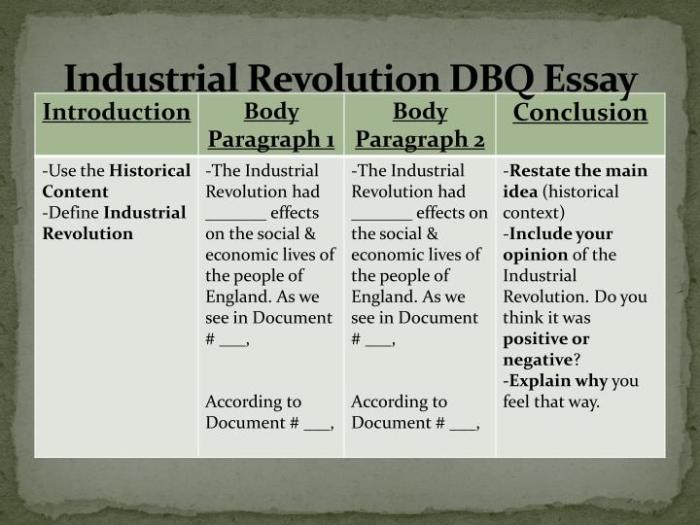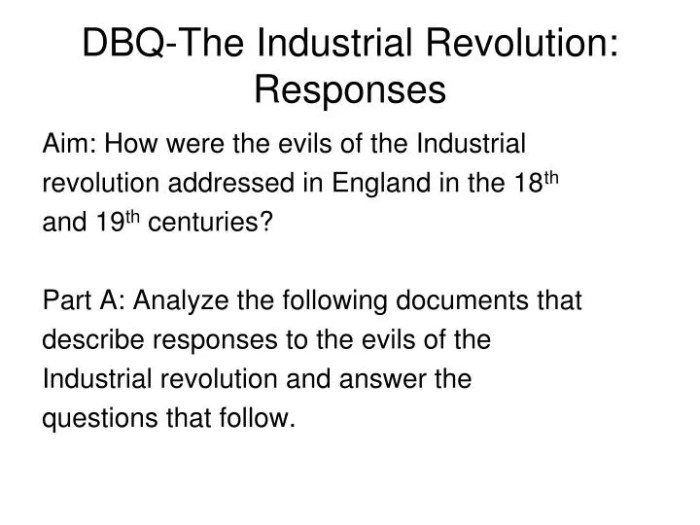The DBQ on the Industrial Revolution delves into the transformative period that reshaped the world, ushering in unprecedented technological advancements, economic shifts, and social upheavals. This essay will explore the major innovations, economic changes, and social consequences that characterized this era, providing a comprehensive analysis of its profound impact on human history.
The Industrial Revolution, ignited by technological breakthroughs, witnessed the rise of steam power, mechanization, and mass production. These innovations revolutionized industries, leading to increased efficiency, productivity, and a shift from agrarian to industrial economies. Capitalism emerged as the dominant economic system, driving industrial development and shaping global trade dynamics.
Technological Advancements

The Industrial Revolution was a period of rapid technological advancement that transformed the way goods were produced. These innovations had a profound impact on production, efficiency, and labor, ultimately shaping the modern world as we know it.
One of the most significant technological innovations of this period was the steam engine. Invented by James Watt in 1769, the steam engine provided a reliable and powerful source of energy that could be used to power factories and transportation systems.
This allowed for the mass production of goods and the transportation of raw materials and finished products over long distances.
Another important innovation was the cotton gin, invented by Eli Whitney in 1793. The cotton gin revolutionized the textile industry by automating the process of removing seeds from cotton fibers. This greatly increased the efficiency of cotton production and made it possible to produce large quantities of cotton cloth at a lower cost.
The development of the power loom, invented by Edmund Cartwright in 1785, further increased the efficiency of the textile industry. The power loom automated the process of weaving cloth, making it possible to produce large quantities of fabric in a shorter amount of time.
These innovations, combined with the use of new materials such as iron and steel, led to a dramatic increase in the production of goods and a decrease in the cost of production.
The Industrial Revolution also had a profound impact on labor. The introduction of machinery led to the displacement of many workers from their traditional jobs. This led to a decline in the demand for skilled labor and an increase in the demand for unskilled labor.
The working conditions in factories were often harsh and dangerous, and workers were often forced to work long hours for low pay.
Despite these negative consequences, the Industrial Revolution also created new opportunities for workers. The development of new industries led to the creation of new jobs, and the increased demand for goods and services led to higher wages for many workers.
The Industrial Revolution also led to the development of new social and political movements, such as the labor movement, which fought for the rights of workers.
Economic Transformations

The Industrial Revolution sparked profound economic transformations, leading to a shift from agrarian to industrial economies. The emergence of capitalism played a pivotal role in driving industrial development, shaping the economic landscape of the era.
Shift from Agrarian to Industrial Economies
Prior to the Industrial Revolution, economies were primarily agrarian, with a majority of the population engaged in agriculture. However, with the advent of mechanization and technological advancements, farming became more efficient, leading to increased productivity and a surplus of agricultural goods.
This surplus allowed for the release of labor from the agricultural sector, creating a workforce available for industrial employment.
Emergence of Capitalism
Capitalism emerged as the dominant economic system during the Industrial Revolution. This system emphasized private ownership of capital and the pursuit of profit. Investors provided capital for industrial ventures, hoping to generate returns on their investments. The profit motive fueled innovation, driving technological advancements and the expansion of industrial production.
Social Impacts: Dbq On The Industrial Revolution
The Industrial Revolution brought about profound social and cultural transformations. The rise of factories and the mechanization of production led to a fundamental shift in the way people lived and worked, shaping societies in unprecedented ways.
One of the most significant consequences of the Industrial Revolution was the growth of cities. As factories sprang up, workers flocked to urban centers in search of employment, resulting in a rapid expansion of urban populations. This influx of people led to overcrowding, poor living conditions, and the emergence of slums.
The Rise of the Working Class
The Industrial Revolution also gave rise to the working class. Prior to this period, most people worked in agriculture or as artisans. However, with the advent of factories, a new class of wage laborers emerged. These workers often worked long hours in dangerous conditions for low pay, leading to widespread poverty and social unrest.
Impact on Family Structures
The Industrial Revolution also had a significant impact on family structures. As men left their homes to work in factories, women increasingly took on the role of primary caregivers. This shift in family dynamics led to a decline in the traditional patriarchal family structure and the rise of more egalitarian relationships.
Education and Leisure Time
The Industrial Revolution also transformed education and leisure time. With the rise of the working class, there was a growing demand for education to improve job prospects. This led to the establishment of public schools and the expansion of literacy rates.
Additionally, the Industrial Revolution brought about a reduction in working hours, which gave rise to the concept of leisure time, allowing people to pursue activities beyond work.
Global Effects
The Industrial Revolution had a profound international impact, leading to the spread of industrialization to other regions of the world and significantly altering trade, colonialism, and global power dynamics.
Spread of Industrialization
The Industrial Revolution initially emerged in Great Britain, but its transformative effects soon spread to other countries. By the mid-19th century, industrialization had taken hold in Western Europe, North America, and Japan. The establishment of factories, railroads, and other industrial infrastructure in these regions led to increased productivity, economic growth, and urbanization.
Impact on Trade
The Industrial Revolution revolutionized global trade patterns. The production of manufactured goods on a large scale led to a decline in the demand for agricultural products from non-industrialized countries. This resulted in a shift in the global economy, with industrialized nations becoming more dominant and non-industrialized nations facing economic challenges.
Colonialism and Global Power Dynamics
The Industrial Revolution played a significant role in the expansion of colonialism. Industrialized nations sought access to raw materials and new markets for their products. This led to the colonization of many regions of Africa, Asia, and South America. The technological and economic advantages of industrialized nations gave them a dominant position in global affairs, shaping the political and economic landscape of the world.
Environmental Consequences
The Industrial Revolution brought about significant environmental changes due to increased resource extraction, industrial processes, and the burning of fossil fuels.
The rapid industrialization led to the depletion of natural resources, such as forests, minerals, and water. Deforestation occurred to provide timber for construction, fuel, and paper production. Mining activities released harmful substances into the environment, contaminating water sources and soil.
Pollution
Industrial processes emitted vast amounts of pollutants into the air, water, and land. Factories released toxic gases, including sulfur dioxide, nitrogen oxides, and carbon monoxide. These pollutants contributed to air pollution, smog, and acid rain. Water pollution resulted from the discharge of industrial waste into rivers and lakes, contaminating aquatic ecosystems.
Climate Change, Dbq on the industrial revolution
The burning of fossil fuels, primarily coal, released large quantities of carbon dioxide into the atmosphere. This greenhouse gas played a major role in the rise of global temperatures, contributing to climate change and its associated impacts, such as sea-level rise, extreme weather events, and ocean acidification.
Long-Term Implications
The environmental consequences of the Industrial Revolution have long-lasting implications for environmental sustainability. The depletion of natural resources, pollution, and climate change pose significant challenges to ecosystems and human health. Addressing these environmental issues requires sustainable practices, technological advancements, and international cooperation to mitigate the negative impacts and preserve the planet for future generations.
Case Studies
The Industrial Revolution transformed numerous countries and regions, leading to varying degrees of success and challenges. Analyzing these case studies provides valuable insights into the factors influencing industrialization and the lessons learned.
United Kingdom
- The UK emerged as the birthplace of the Industrial Revolution due to factors such as abundant natural resources (coal and iron), a stable political system, and a skilled workforce.
- Government policies, such as patent protection and investment in infrastructure, fostered innovation and economic growth.
United States
- The US experienced rapid industrialization in the 19th century due to its vast natural resources, expanding markets, and technological advancements (e.g., the cotton gin, interchangeable parts).
- Factors such as immigration, westward expansion, and government support (e.g., land grants) contributed to its industrial success.
Japan
- Japan underwent rapid industrialization in the late 19th and early 20th centuries through a combination of government policies (e.g., Meiji Restoration), adoption of Western technology, and a strong work ethic.
- Investment in education and infrastructure played a crucial role in Japan’s industrial transformation.
Russia
- Russia faced challenges in industrializing due to its vast territory, lack of infrastructure, and inefficient government policies.
- The Soviet Union’s centralized planning and emphasis on heavy industry led to mixed results, with some sectors achieving success while others struggled.
FAQ Guide
What were the key technological innovations of the Industrial Revolution?
The steam engine, mechanization, and mass production were among the most significant technological innovations.
How did the Industrial Revolution impact economic systems?
It led to a shift from agrarian to industrial economies, and the emergence of capitalism as the dominant economic system.
What were the major social consequences of the Industrial Revolution?
It resulted in the growth of cities, the rise of the working class, and changes in family structures, education, and leisure time.